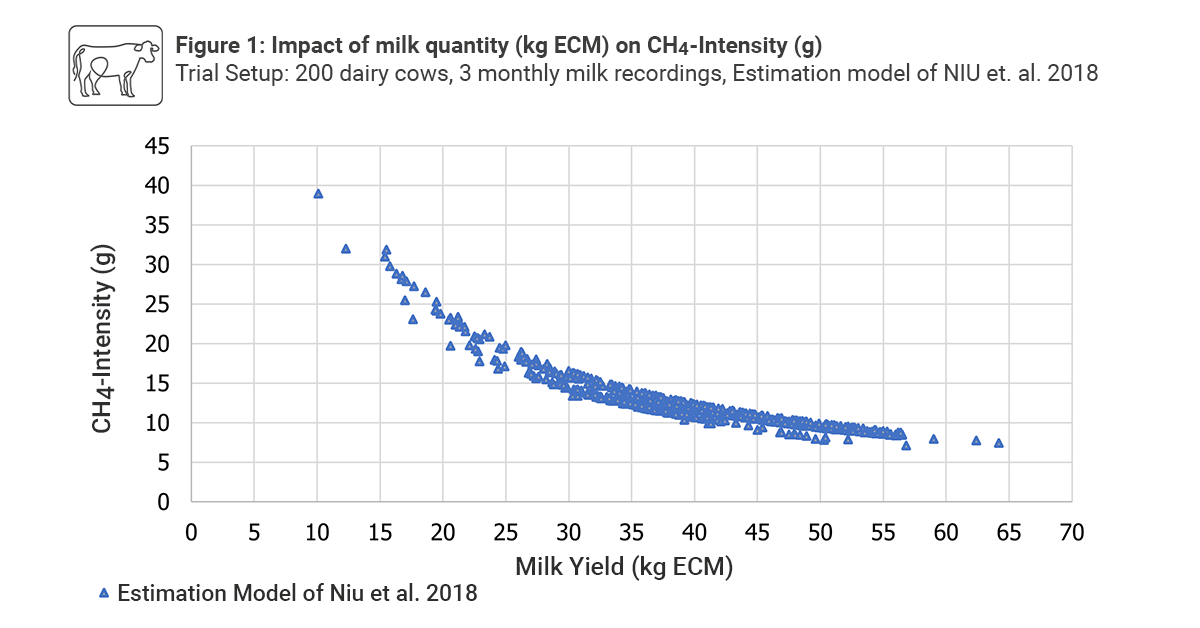METHANE EMISSIONS
Up to 23% of the anthropogenic greenhouse gases (GHG) carbon dioxide (CO2), methane (CH4), and nitrous oxide (N2O) come from agriculture, forestry, and land-use change (IPCC 2019). As a by-product of enteric fermentation, ruminants account for 6% of anthropogenic CH4 production (Beauchemin et al. 2020). CH4 emissions can be influenced via feeding and an improvement in production performance (Knapp et al. 2014).
QUANTIFICATION OF CH4 – EVALUATION OF CH4 INTENSITY USING PRACTICAL FARM DATA
Techniques for animal-specific CH4 measurement, such as the respiration chamber, are expensive and on-farm use is limited (Hammond et al. 2016). Alternatively, quantification of CH4 is possible using predictive models based on extensive datasets of animals (Niu et al. 2018). These are based on the parameters available on farms, such as average feed intake, ration parameters, milk yield, and milk production parameters. Based on an international data set Niu et al. (2018) considered dry matter intake (DMI, kg/day) and neutral detergent fiber contents (NDF, % of the diet):
CH4 [g]= -26,0 (16,67) + 15,3 (0,41) x DMI + 3,42 (0,309) x NDF
The above described estimation model was used with a descriptive data set based on daily farm data from the dairy herd of Gut Hülsenberg (Wahlstedt, DE). The CH4 intensity g/kg energy corrected milk (ECM, corrected to 4% fat and 3% protein) of the 200 dairy cows was determined based on the average feed intake, milk yield and milk quantity data from three monthly milk recordings (period 09/22 – 11/22) (Figure 1). The diet fed during this period was kept at a stable composition and contained grass silage (35.2%), corn silage (23.6%) and 41.2% concentrate mix (rapeseed extraction meal, dried beet pulp, corn, corn DDGS barley and including the mineral feed). There is a clear negative correlation of ECM yield and CH4 intensity (Figure 1). This means that dairy cows with a higher milk yield have a better CH4 efficiency.

APPLIED IMPLICATION – IMPROVEMENT OF THE FORAGE UTILIZATION EFFICIENCY
Improving the digestibility of the forage has a positive effect on feed efficiency and animal productivity, so that CH4 intensity/kg ECM is reduced.
Firstly, the preservation of the forage with the use of silage inoculants positively affects the quality and digestibility of the feed. Our silage inoculant range BONSILAGE based on dedicated homo- and heterofermentative lactic acid bacteria has been proven to support the quality and digestibility of forage. BONSILAGE products are targeted to various crop types and a wide dry matter range.

Second, the optimization of ruminal fermentation offers great potential to improve the productivity of the animals. Our solid-state fermentation product MAXFIBER, a fungal fermentation product with a vast range of exogenous fibrolytic enzymes, promotes cell wall degradation and optimizes rumen metabolism. Therefore, the nutrient utilization of the forage can be increased, and the animal performance is higher. The application of MAXFIBER in an in vivo trail performed by the University of Pelotas (Brasil) in 2019 shows an improved milk yield (kg/d, p = 0.05) and diet digestibility (see Figure 2). Thus, the efficiency of the cows was increased and based on the results from Figure 1, a reduction in CH4-intensity can be assumed.
References available upon request. Please contact Michelle Mehrens for any questions.
Moreover, we proudly received the English certificate for independent verification of on-farm methane intensity quantification and forage-related mitigation options. This assessment demonstrates that using MAXFIBER and BONSILAGE improves dairy production efficiency, resulting in lower methane emissions per kg of milk or meat. Please click the button below to view the certificate.

 Deutschland
Deutschland International
International Brasil
Brasil Español
Español